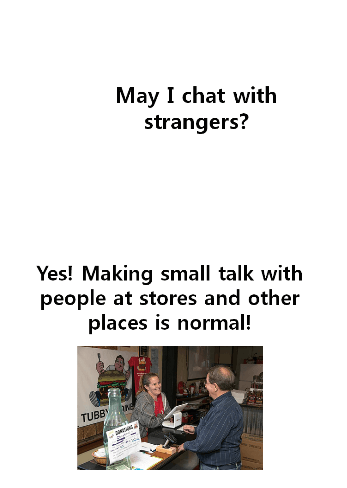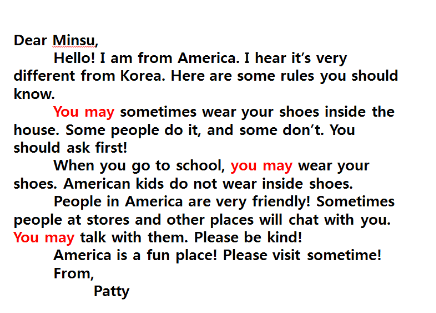In the EPIK program in South Korea, for every three hours of ESL speaking and listening instruction elementary school students receive, they get only one hour of reading and one hour of writing instruction. So, what can be done to help address the lack of reading and writing instruction in the EPIK classroom, or at least to maximize the benefit the students reap from the little reading and writing time they do get?
In this article, OnTESOL Graduate Patricia Brooks will show you how to help fifth graders in South Korea to improve their writing skills. In this example, Patricia supplements a part of the Cheonjae Grade 5 textbook that teaches asking permission and expressing prohibition (target grammar: “May I _____?” “Yes, you may [____]”/ “No, you may not [____].”) with a letter-writing activity meant to introduce the kids to things that are and are not permissible in American culture and compare them with behavioral norms in South Korea.
Find TESOL / TEFL jobs in South Korea and apply directly on the OnTESOL job board.
Recommended TESOL certification for teaching with EPIK or private hagwons in South Korea: 120-hour Advanced TESOL + 20-hour TEYL Specialist (Combine and save CA$199 / US$150!)
“You may not wear your shoes in the house.”
Letter-Writing Activity for Grade 5 ESL Classes in South Korea:
One of the final lessons in the fifth-grade Cheonjae textbook, titled “May I Take Pictures Here?”, is based on the theme of asking and expressing permission. Their key expressions for the lesson included sentences such as, “May I bring my cat?” and “Sorry, you can’t swim here.”
The theme seems to be more specifically focused on asking permission to do things in settings such as museums and schools, but other common locations such as public parks are also represented in the video clips that accompany the Cheonjae textbook.
By the end of the ESL lesson students should be able to:
- ask for permission to do actions including taking photos, entering a space, and getting a drink of water.
- respond to the aforementioned questions when asked by others
- form unprompted prohibitory or permissive statements such as “You can’t eat here.”
- Being able to read and write the target grammar point.

ESL students are not asked to write their own complete sentences, so I decided to challenge my students with a letter-writing activity, in which they told a fictional American pen pal about what one can and can’t do in Korea and ask their “pen pal” what they are allowed to do in America.
To get my ESL students interested in the topic, I asked them what they thought about America (what kinds of ideas they had of the people there, what they thought Americans did for fun, and so on).
I then asked if they think that Americans follow the same rules as Koreans do. The question caused a bit of confusion in the group. The rules that they have grown up with are all that they know, and it seemed strange to consider anyone not following the rules that have shaped their behavior since birth.
At the same time, having even a slight degree of familiarity with American culture through media such as film and music, they all came to the consensus that the rules must be different somehow. But how? Rather than simply telling the students the rules of American society, I let them guess! This adds an element of excitement and interest that is hard to spark when simply talking in the class.
Each cultural rule was presented in a Powerpoint presentation as a yes-or-no question using the target grammar, for example, “May I chat with strangers?” After the students guessed yes or no, I showed them the answer and briefly explained that aspect of American culture.
Some of the answers surprised them more than I expected! I told the kids that Americans often make small talk with strangers and told them of a time when I was boarding a plane and the employee checking my boarding pass complimented my carry-on and said that she had the same exact one. While little pleasantries of that sort are fairly common in the States, such an exchange is near unthinkable here in South Korea!
After introducing a few of the “can”s and “can’t”s of American culture, I asked the students to think about things that they are and are not allowed to do here in South Korea. They gave me rules such as, “You may not wear shoes inside” and “You may run and play inside the school,” and I wrote their responses on the board. 
What really helped them understand not only the task but also the proper letter-writing structure was showing them my own example, as American writing to a Korean pen pal and talking about American cultural norms. We read my example letter together as a class, and the students were then given letterforms on which to write.
Armed with the American cultural information I had given them earlier in the lesson, the list of brainstormed South Korean cultural norms on the board, dictionaries, and of course a teacher to ask questions to if all else failed, my students went to work.
They had fun finding ways to explain Korean cultural rules using their English, and being able to write about something about which they are very knowledgeable made even lower-level students feel engaged. In the end, most students were able to complete their letters within the same class period and even the students were surprised by the quality of their own work.
The main takeaway from this lesson are that writing lessons do not have to be boring! Writing can move away from the rigid, uninteresting textbook drills to personally relevant and fun projects. Just make sure to give students students a prompt that they know enough to respond to in a meaningful way, adequate structure and information leading up to the activity, and tools to get more information and help as needed during the activity time.
Study TESOL online with OnTESOL. Get free job assistance in South Korea and other top destinations.





